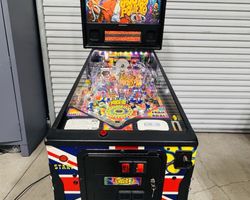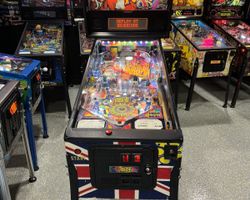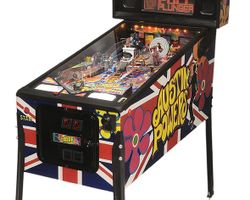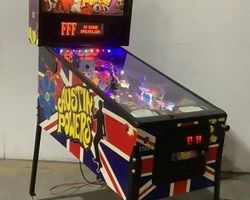Austin Powers™
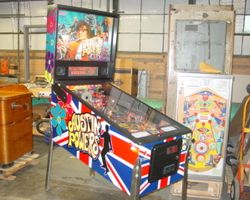
Average Prices: USD $1,500 to $3,700
Produced: June, 2001
Machine Type: Solid State Electronic
MPU: Sega/Stern Whitestar
Players: 4
Concept by: John Borg, Lonnie D. Ropp
Design by: Lonnie D. Ropp
Dots/Animation by: Mark Galvez
Mechanics by: John Borg, Wesley Chang
Music by: Kyle Johnson
Sound by: Kyle Johnson
Software by: Lonnie D. Ropp, Keith P. Johnson
Released in June 2001, Austin Powers by Stern Pinball, Inc. brought the Groovy Agent's world to the silver ball. This machine marked an interesting period for Stern, leveraging popular cinema licenses to create engaging pinball experiences. The decision to base a pinball machine on the Austin Powers film series tapped into the comedic spy genre, aiming to capture the humor and distinct aesthetic of the movies.
The machine's creation was a collaborative effort. Lonnie D. Ropp served as the primary designer and a key software contributor. John Borg contributed to the concept and mechanics, while Wesley Chang also worked on the mechanical aspects. Keith P. Johnson joined Ropp on the software development, ensuring the game's intricate rules and modes functioned smoothly. The auditory landscape of the game was crafted by Kyle Johnson, responsible for both the music and sound effects, vital for conveying the comedic tone. Mark Galvez handled the animation, bringing the characters and iconic scenes to life on the dot matrix display. Production of Austin Powers was limited, with approximately 800 units manufactured, making it a relatively rare title in Stern's early 2000s catalog. An interesting piece of trivia points to the existence of roughly ten special "Gold Edition" machines, reportedly created for cast members of the films. These unique versions featured gold trim, a numbered plaque, and a playfield signed by Gary Stern himself. Another notable historical detail reflects the post-9/11 era: a software update (V3.00) was released that allowed operators to remove all references to Washington D.C. from the game's content, a direct response to the sensitivities of the time. Furthermore, eagle-eyed players might recognize some recycled DMD animation; the sequence depicting the White House being destroyed by the Big Frickin' Laser was adapted from Stern's earlier Independence Day pinball machine.
Signature Features and Design
Austin Powers stands out with several bespoke mechanical toys and design elements that immerse players in the world of espionage and comedy. At the heart of the action is the "Frickin' Laser Beam," a rotating ball cannon positioned behind the flippers. Players engage this feature using a dedicated "fire" button on the lockdown bar, attempting to launch the ball into the main scoop for big points. This interactive cannon adds a layer of precision shooting not commonly found on other machines.
Another prominent feature is the animated Dr. Evil figure, which rises from the playfield. This motorized target, reminiscent of dynamic toys in other popular titles, provides a central bash target and serves as a visual anchor, enhancing the thematic integration. Complementing Dr. Evil is the "Time Machine," a vertical spinning magnet with a spiral design. This magnet not only physically interacts with the ball, adding an element of unpredictability and skill to specific shots, but also serves as a gateway to one of the game's multiball modes. The "Mini-Me Spinner," shaped like the character, adds a unique visual flourish and acts as a key shot for a specific hurry-up mode, though its spinning effectiveness has been a point of discussion among players.
Humor is woven into the machine's very fabric, exemplified by the "Fat Bastard's Toilet," a scoop designed to resemble a toilet seat. This whimsical target is crucial for starting one of the game's more memorable multiball experiences. Adding to the kinetic spectacle, a "dancing" Austin Powers puppet, operated by a magnet, can be seen above the right scoop. These distinct toys and mechanisms are not merely decorative; they are integrated into the gameplay, requiring players to interact with them to progress through modes and achieve high scores, thus reinforcing the machine's thematic connection. The artwork throughout the machine, from the bright, colorful cabinet art to the playfield, embraces the vibrant, often psychedelic, 1960s aesthetic of the movies. While the cabinet art generally receives positive remarks, the playfield art has garnered mixed opinions, with some appreciating its adherence to the theme and others finding aspects of it blurry or less refined.
Playfield and Mechanics
The Austin Powers playfield is designed around a mode-centric ruleset, featuring a layout that encourages a variety of shots to progress. It includes a total of four ramps, which contribute to the game's flow and provide distinct shot opportunities. The "Big Frickin' Laser" ramp on the left side is a key shot, leading to a significant mode. The right ramp offers another path to mode progression. The "Fat Bastard Ramp" leads directly to the "Fat Bastard's Toilet" scoop, a critical target for activating a four-ball multiball. The fourth ramp, accessible from the Time Machine area, offers an alternative route.
Three pop bumpers are situated at the top-center of the playfield, positioned to keep the ball in motion and feed shots towards the various targets. Two main flippers at the bottom provide the primary means of controlling the ball. Key targets include the "MOJO Standups" and additional standup targets on the left and right, all integral for activating different game features and building bonus scores. The "Austin Powers Hole" is a scoop that serves as a primary mode start shot and a general collection point.
The playfield also incorporates the "Mini-Me Spinner," a mechanical spinner that lights a hurry-up when spun rapidly. The centerpiece "Time Machine" is a spinning disk with a hole, requiring precision to shoot the ball into it, leading to the "Time Machine Multiball." The motorized "Dr. Evil" figure acts as a bash toy, central to triggering "MOJO Multiball." Below the pop bumpers, a series of rollover lanes contribute to the bonus multiplier, encouraging strategic nudging and controlled shots. The overall design philosophy emphasizes hitting specific shots to advance through the game's modes, with the various toys acting as literal and figurative gateways to higher scoring opportunities. The bright, sometimes chaotic, artwork on the playfield aligns with the flamboyant nature of the Austin Powers films, though opinions on its visual clarity and quality vary. The lighting scheme uses a combination of general illumination and targeted inserts to guide the player towards active shots and indicate mode progression, creating a dynamic visual experience.
Gameplay Dynamics
Austin Powers employs a mode-based gameplay structure, challenging players to complete six distinct modes to reach the ultimate "Moon-base Multiball." Each mode has a specific objective and a clear completion goal, indicated by flashing lights on the playfield. Successfully completing a mode not only awards a base score, starting at 1 million points, but also makes that mode available for replay for additional points, encouraging players to master each sequence.
The six primary modes are:
- Mini Me: Requires players to rapidly spin the Mini Me spinner to build up and collect a hurry-up score.
- Fat Bastard: Involves shooting the Fat Bastard ramp repeatedly to light and start "Fat Bastard Multiball," a four-ball frenzy where players aim for jackpots.
- Frickin' Laser: Activated by shooting the "Big Frickin' Laser" ramp, this mode often involves using the physical laser cannon to target the main scoop for substantial points (around 30 million for a successful shot).
- Time Machine: Players must accurately shoot the ball into the hole in the spinning "Time Machine" disk to initiate "Time Machine Multiball," a two-ball multiball with its own jackpot opportunities.
- Sub-Drill: This mode requires players to hit both the left and right ramps to complete its objective.
- Henchmen: A timed mode where players need to hit all six main shots on the playfield within a given time limit.
Beyond the main modes, Austin Powers features several multiball variations. "MOJO Multiball" is a two-ball multiball initiated by repeatedly bashing the Dr. Evil motorized target. The most challenging multiballs are "Virtucon Multiball," a six-ball mode triggered after completing the sixth main mode, and the final "Moon-base Multiball," which becomes accessible after completing all six primary modes, offering the potential for massive scoring.
A continuous objective in the game is spelling "S-H-A-G" via the inlanes and outlanes, which initiates a "SHAG Hurryup" for bonus points and can trigger a ball saver during single-ball play. The bonus multiplier is increased by rolling over specific lanes at the top of the playfield. An extra ball is typically awarded for starting the fourth mode, providing a tangible goal for players. The skill shot, performed at the beginning of each ball by carefully plunging to a specific lane, offers a considerable initial bonus, typically around 6 million points, setting the stage for a strong start. The interplay between modes and multiballs creates a dynamic experience, though multiball modes generally take precedence, temporarily pausing mode progress.
Reception and Legacy
The reception for Austin Powers within the pinball community has been notably mixed, often polarizing players. Its most significant strength, widely acknowledged, is its successful integration of the Austin Powers movie theme. The game is replete with authentic voice clips, sound effects, and musical cues from the films, coupled with cabinet art that many appreciate for its vibrant and faithful representation of the source material. The humor inherent in the franchise translates effectively to the pinball experience, with many players finding the callouts and animations genuinely funny and entertaining. The physical toys, such as the rising Dr. Evil, the Time Machine magnet, and the "Frickin' Laser" cannon, are frequently cited as positive, engaging features that add to the game's unique character. For casual players or those deeply familiar with the movies, the machine is often regarded as accessible and enjoyable, providing a fun, lighthearted experience.
However, Austin Powers also faces considerable criticism. A recurring complaint centers on the perceived repetitiveness of its gameplay. Many players find that despite the different modes, the shot execution often feels similar, leading to a sense of monotony over longer play sessions. The playfield artwork is a significant point of contention; while some defend its bright, thematic style, others criticize it as blurry, uninspired, or amateurish, particularly when compared to other machines of its era. Sound quality has also been cited as an area for improvement by some reviewers. Mechanical reliability of certain features, notably the "Fat Bastard's Toilet" shot, which sometimes fails to register, and the "Mini-Me Spinner," often criticized for not spinning freely, contributes to player frustration. Some also point to the overall build quality as being less robust than desired, occasionally categorizing it as a "typical Stern build" of that period, which implies component longevity issues for certain critics.
Ruleset depth is another area where the machine draws criticism. Some players find the rules shallow and the scoring unbalanced, lacking the intricate strategic layers present in more highly regarded titles. Quick ball drains and repetitive music are also common grievances. Despite these criticisms, Austin Powers holds a distinct place in Stern's history. It represents an early example of Stern's strategy of leveraging popular movie licenses, a practice that would become a cornerstone of their business. While not universally lauded as a competitive player's machine, its strong thematic integration and comedic appeal ensure it maintains a dedicated following among fans of the franchise and collectors seeking a fun, light-hearted game for their collection. Its legacy is perhaps less about revolutionizing pinball design and more about its role as a solid, if flawed, example of early 21st-century licensed pinball, capable of delivering pure, unadulterated fun for the right audience.
Sponsored Links
 Ebay Listings
Ebay Listings
 Auction Results
Auction Results
| Cost | Location | Date |
|---|---|---|
| USD $3,900 |  New Jersey, United States New Jersey, United States |
23 October, 2025 |
| USD $6,999 |  California, United States California, United States |
27 July, 2025 |
| USD $4,999 |  Florida, United States Florida, United States |
14 July, 2025 |
| USD $4,200 |  California, United States California, United States |
07 July, 2025 |
| USD $5,799 |  California, United States California, United States |
27 May, 2025 |
| USD $4,000 |  Indiana, United States Indiana, United States |
04 February, 2025 |
| USD $4,975 |  Indiana, United States Indiana, United States |
03 February, 2025 |
| USD $3,800 |  Georgia, United States Georgia, United States |
30 November, 2024 |
| USD $4,000 |  California, United States California, United States |
18 November, 2024 |
| USD $3,750 |  Florida, United States Florida, United States |
17 October, 2024 |


Private Policy · Search Website · Contact Us
As an eBay Partner, we may earn a commission from qualifying purchases made through links on this site, at no additional cost to you.
All trademarks and copyrighted materials remain property of their respective owners. All other content copyright 2007 - 2025 Pinpedia.


